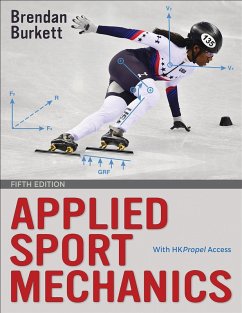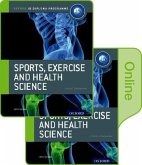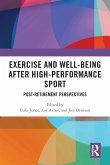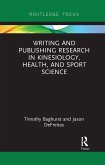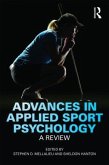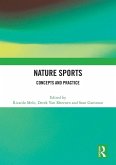Brendan Burkett
Applied Sport Mechanics
Brendan Burkett
Applied Sport Mechanics
- Broschiertes Buch
- Merkliste
- Auf die Merkliste
- Bewerten Bewerten
- Teilen
- Produkt teilen
- Produkterinnerung
- Produkterinnerung
Applied Sport Mechanics, Fifth Edition, explores how the fundamental laws of human movement affect athletes’ performances. Foundational principles of kinetics, kinematics, and sport technique are clearly presented and then explored through a variety of applied scenarios.
Andere Kunden interessierten sich auch für
![Oxford IB Diploma Programme: IB Sports, Exercise and Health Science Print and Online Course Book Pack Oxford IB Diploma Programme: IB Sports, Exercise and Health Science Print and Online Course Book Pack]() John SprouleOxford IB Diploma Programme: IB Sports, Exercise and Health Science Print and Online Course Book Pack109,99 €
John SprouleOxford IB Diploma Programme: IB Sports, Exercise and Health Science Print and Online Course Book Pack109,99 €![Exercise and Well-Being after High-Performance Sport Exercise and Well-Being after High-Performance Sport]() Exercise and Well-Being after High-Performance Sport55,99 €
Exercise and Well-Being after High-Performance Sport55,99 €![European Conference on Physical Education and School Sport European Conference on Physical Education and School Sport]() European Conference on Physical Education and School Sport19,95 €
European Conference on Physical Education and School Sport19,95 €![Writing and Publishing Research in Kinesiology, Health, and Sport Science Writing and Publishing Research in Kinesiology, Health, and Sport Science]() Timothy BaghurstWriting and Publishing Research in Kinesiology, Health, and Sport Science28,99 €
Timothy BaghurstWriting and Publishing Research in Kinesiology, Health, and Sport Science28,99 €![Advances in Applied Sport Psychology Advances in Applied Sport Psychology]() Advances in Applied Sport Psychology64,99 €
Advances in Applied Sport Psychology64,99 €![Managing Elite Sport Systems Managing Elite Sport Systems]() Managing Elite Sport Systems72,99 €
Managing Elite Sport Systems72,99 €![Nature Sports Nature Sports]() Nature Sports58,99 €
Nature Sports58,99 €-
-
-
Applied Sport Mechanics, Fifth Edition, explores how the fundamental laws of human movement affect athletes’ performances. Foundational principles of kinetics, kinematics, and sport technique are clearly presented and then explored through a variety of applied scenarios.
Produktdetails
- Produktdetails
- Verlag: Human Kinetics Publishers
- Fifth Edition
- Seitenzahl: 288
- Erscheinungstermin: 19. November 2025
- Englisch
- Abmessung: 279mm x 216mm
- ISBN-13: 9781718234840
- ISBN-10: 1718234848
- Artikelnr.: 74438597
- Herstellerkennzeichnung
- Libri GmbH
- Europaallee 1
- 36244 Bad Hersfeld
- gpsr@libri.de
- Verlag: Human Kinetics Publishers
- Fifth Edition
- Seitenzahl: 288
- Erscheinungstermin: 19. November 2025
- Englisch
- Abmessung: 279mm x 216mm
- ISBN-13: 9781718234840
- ISBN-10: 1718234848
- Artikelnr.: 74438597
- Herstellerkennzeichnung
- Libri GmbH
- Europaallee 1
- 36244 Bad Hersfeld
- gpsr@libri.de
Brendan Burkett, PhD, is a professor at the University of the Sunshine Coast in Queensland, Australia. He received his undergraduate and master’s degrees in engineering and attained his doctorate in biomechanics. Burkett’s teaching specializations are biomechanics, sport coaching, and performance enhancement. His research revolves around technology developments in human health and performance, and he has written more than 180 peer-reviewed articles and 240 conference publications for journals in sport science, biomechanics, and coaching. As an international elite athlete, Burkett represented Australia for 13 years as a swimmer. He was a Paralympic champion, world champion, and world-record holder, and he was the winner of multiple medals in the Commonwealth Games and Australian national championships. He served as the Australian team captain for the 1996 Atlanta Paralympic Games and as the flag bearer for the opening ceremonies of the Sydney 2000 Olympic Games. Following his sporting career Burkett has been the sport scientist for the Australian Paralympic team for the 2002, 2006, 2010, 2014, 2018, and 2022 World Championships and the 2004, 2008, 2012, 2016, and 2020 Paralympic Games. He has attended the past nine consecutive Paralympic Games, from 1988 to 2020, and was the head coach of the Australian Paralympic Swim Team from 2018 through 2022. Burkett has received several awards, including the Australia Day Sporting Award and the Order of Australia Medal (OAM), as well as induction into the Sunshine Coast Sports Hall of Fame, Swimming Queensland Hall of Fame, and the Queensland Sport Hall of Fame.
Part I. Fundamentals of Movement in Sports
Chapter 1. Introduction to Applied Sport Mechanics
How Applied Sport Mechanics Is Organized
What Is Sport Mechanics?
Understanding and Quantifying Technique
Summary
Key Terms
References
Chapter 2. Anatomical Requirements for Sport
Standard Anatomical Reference Terminology
Connection Between Human Anatomy and Sport Mechanics
Summary
Key Terms
References
Chapter 3. Fundamentals of Sport Mechanics
How to Describe Human Motion
Applying Sport Mechanics to Resistance Training
Measurement and Evaluation in Sport Mechanics
Summary
Key Terms
References
Chapter 4. Fundamentals of Sport Kinetics
Work
Power
Energy
Rebound
Friction
Summary
Key Terms
References
Part II. Applications in Sport
Chapter 5. Linear Motion
Linear Motion Measures (Speed, Velocity, and Acceleration)
Linear Motion for Projectiles
Summary
Key Terms
References
Chapter 6. Linear Kinetics
Fundamental Principles of Linear Kinetics
Momentum and Impulse in Sport
How to Measure Linear Kinetics: Running Gait
Summary
Key Terms
References
Chapter 7. Angular Motion
Fundamental Principles of Angular Motion
Applied Angular Motion: How an Athlete Initiates Rotation
Summary
Key Terms
References
Chapter 8. Angular Kinetics
Gravity: Fundamental Principle of Angular Kinetics
Angular Momentum
Summary
Key Terms
References
Chapter 9. Stability and Instability
Fundamental Principles for Stability
Mechanical Principles for Stability
Factors That Increase Stability
How to Measure Center of Gravity and Line of Gravity for an Athlete
Summary
Key Terms
References
Chapter 10. Moving Through Fluids
Fundamental Principles of Moving Through Fluids
Hydrostatic Pressure and Buoyancy
Drag and Lift
Factors That Influence Moving Through Air and Water
Summary
Key Terms
References
Part III. Putting Your Knowledge of Sport Mechanics to Work
Chapter 11. Analyzing Sport Skills
Step 1: Determine the Objectives of the Skill
Step 2: Note Any Special Characteristics of the Skill
Step 3: Study Top-Flight Performances of the Skill
Step 4: Divide the Skill Into Phases
Step 5: Divide Each Phase Into Key Elements
Step 6: Understand the Mechanical Reasons That Each Key Element Is
Performed as It Is
Summary
Key Terms
References
Chapter 12. Identifying and Correcting Errors in Sport Skills
Step 1: Observe the Complete Skill
Step 2: Analyze Each Phase and Its Key Elements
Step 3: Use Your Knowledge of Sport Mechanics in Your Analysis
Step 4: Select Errors to Be Corrected
Step 5: Decide on Appropriate Methods for the Correction of Errors
Summary
Key Terms
References
Chapter 13. Optimizing Sport Mechanics
Sprinting
Jumping
Wheelchair Sports
Throwing
Striking and Batting
Swinging and Rotating
Weightlifting
Combat Throwing
Tackle in Football
Swimming
Kicking a Ball
Paddling a Watercraft
Summary
References
Appendix. Units of Measurement and Conversions
Chapter 1. Introduction to Applied Sport Mechanics
How Applied Sport Mechanics Is Organized
What Is Sport Mechanics?
Understanding and Quantifying Technique
Summary
Key Terms
References
Chapter 2. Anatomical Requirements for Sport
Standard Anatomical Reference Terminology
Connection Between Human Anatomy and Sport Mechanics
Summary
Key Terms
References
Chapter 3. Fundamentals of Sport Mechanics
How to Describe Human Motion
Applying Sport Mechanics to Resistance Training
Measurement and Evaluation in Sport Mechanics
Summary
Key Terms
References
Chapter 4. Fundamentals of Sport Kinetics
Work
Power
Energy
Rebound
Friction
Summary
Key Terms
References
Part II. Applications in Sport
Chapter 5. Linear Motion
Linear Motion Measures (Speed, Velocity, and Acceleration)
Linear Motion for Projectiles
Summary
Key Terms
References
Chapter 6. Linear Kinetics
Fundamental Principles of Linear Kinetics
Momentum and Impulse in Sport
How to Measure Linear Kinetics: Running Gait
Summary
Key Terms
References
Chapter 7. Angular Motion
Fundamental Principles of Angular Motion
Applied Angular Motion: How an Athlete Initiates Rotation
Summary
Key Terms
References
Chapter 8. Angular Kinetics
Gravity: Fundamental Principle of Angular Kinetics
Angular Momentum
Summary
Key Terms
References
Chapter 9. Stability and Instability
Fundamental Principles for Stability
Mechanical Principles for Stability
Factors That Increase Stability
How to Measure Center of Gravity and Line of Gravity for an Athlete
Summary
Key Terms
References
Chapter 10. Moving Through Fluids
Fundamental Principles of Moving Through Fluids
Hydrostatic Pressure and Buoyancy
Drag and Lift
Factors That Influence Moving Through Air and Water
Summary
Key Terms
References
Part III. Putting Your Knowledge of Sport Mechanics to Work
Chapter 11. Analyzing Sport Skills
Step 1: Determine the Objectives of the Skill
Step 2: Note Any Special Characteristics of the Skill
Step 3: Study Top-Flight Performances of the Skill
Step 4: Divide the Skill Into Phases
Step 5: Divide Each Phase Into Key Elements
Step 6: Understand the Mechanical Reasons That Each Key Element Is
Performed as It Is
Summary
Key Terms
References
Chapter 12. Identifying and Correcting Errors in Sport Skills
Step 1: Observe the Complete Skill
Step 2: Analyze Each Phase and Its Key Elements
Step 3: Use Your Knowledge of Sport Mechanics in Your Analysis
Step 4: Select Errors to Be Corrected
Step 5: Decide on Appropriate Methods for the Correction of Errors
Summary
Key Terms
References
Chapter 13. Optimizing Sport Mechanics
Sprinting
Jumping
Wheelchair Sports
Throwing
Striking and Batting
Swinging and Rotating
Weightlifting
Combat Throwing
Tackle in Football
Swimming
Kicking a Ball
Paddling a Watercraft
Summary
References
Appendix. Units of Measurement and Conversions
Part I. Fundamentals of Movement in Sports
Chapter 1. Introduction to Applied Sport Mechanics
How Applied Sport Mechanics Is Organized
What Is Sport Mechanics?
Understanding and Quantifying Technique
Summary
Key Terms
References
Chapter 2. Anatomical Requirements for Sport
Standard Anatomical Reference Terminology
Connection Between Human Anatomy and Sport Mechanics
Summary
Key Terms
References
Chapter 3. Fundamentals of Sport Mechanics
How to Describe Human Motion
Applying Sport Mechanics to Resistance Training
Measurement and Evaluation in Sport Mechanics
Summary
Key Terms
References
Chapter 4. Fundamentals of Sport Kinetics
Work
Power
Energy
Rebound
Friction
Summary
Key Terms
References
Part II. Applications in Sport
Chapter 5. Linear Motion
Linear Motion Measures (Speed, Velocity, and Acceleration)
Linear Motion for Projectiles
Summary
Key Terms
References
Chapter 6. Linear Kinetics
Fundamental Principles of Linear Kinetics
Momentum and Impulse in Sport
How to Measure Linear Kinetics: Running Gait
Summary
Key Terms
References
Chapter 7. Angular Motion
Fundamental Principles of Angular Motion
Applied Angular Motion: How an Athlete Initiates Rotation
Summary
Key Terms
References
Chapter 8. Angular Kinetics
Gravity: Fundamental Principle of Angular Kinetics
Angular Momentum
Summary
Key Terms
References
Chapter 9. Stability and Instability
Fundamental Principles for Stability
Mechanical Principles for Stability
Factors That Increase Stability
How to Measure Center of Gravity and Line of Gravity for an Athlete
Summary
Key Terms
References
Chapter 10. Moving Through Fluids
Fundamental Principles of Moving Through Fluids
Hydrostatic Pressure and Buoyancy
Drag and Lift
Factors That Influence Moving Through Air and Water
Summary
Key Terms
References
Part III. Putting Your Knowledge of Sport Mechanics to Work
Chapter 11. Analyzing Sport Skills
Step 1: Determine the Objectives of the Skill
Step 2: Note Any Special Characteristics of the Skill
Step 3: Study Top-Flight Performances of the Skill
Step 4: Divide the Skill Into Phases
Step 5: Divide Each Phase Into Key Elements
Step 6: Understand the Mechanical Reasons That Each Key Element Is
Performed as It Is
Summary
Key Terms
References
Chapter 12. Identifying and Correcting Errors in Sport Skills
Step 1: Observe the Complete Skill
Step 2: Analyze Each Phase and Its Key Elements
Step 3: Use Your Knowledge of Sport Mechanics in Your Analysis
Step 4: Select Errors to Be Corrected
Step 5: Decide on Appropriate Methods for the Correction of Errors
Summary
Key Terms
References
Chapter 13. Optimizing Sport Mechanics
Sprinting
Jumping
Wheelchair Sports
Throwing
Striking and Batting
Swinging and Rotating
Weightlifting
Combat Throwing
Tackle in Football
Swimming
Kicking a Ball
Paddling a Watercraft
Summary
References
Appendix. Units of Measurement and Conversions
Chapter 1. Introduction to Applied Sport Mechanics
How Applied Sport Mechanics Is Organized
What Is Sport Mechanics?
Understanding and Quantifying Technique
Summary
Key Terms
References
Chapter 2. Anatomical Requirements for Sport
Standard Anatomical Reference Terminology
Connection Between Human Anatomy and Sport Mechanics
Summary
Key Terms
References
Chapter 3. Fundamentals of Sport Mechanics
How to Describe Human Motion
Applying Sport Mechanics to Resistance Training
Measurement and Evaluation in Sport Mechanics
Summary
Key Terms
References
Chapter 4. Fundamentals of Sport Kinetics
Work
Power
Energy
Rebound
Friction
Summary
Key Terms
References
Part II. Applications in Sport
Chapter 5. Linear Motion
Linear Motion Measures (Speed, Velocity, and Acceleration)
Linear Motion for Projectiles
Summary
Key Terms
References
Chapter 6. Linear Kinetics
Fundamental Principles of Linear Kinetics
Momentum and Impulse in Sport
How to Measure Linear Kinetics: Running Gait
Summary
Key Terms
References
Chapter 7. Angular Motion
Fundamental Principles of Angular Motion
Applied Angular Motion: How an Athlete Initiates Rotation
Summary
Key Terms
References
Chapter 8. Angular Kinetics
Gravity: Fundamental Principle of Angular Kinetics
Angular Momentum
Summary
Key Terms
References
Chapter 9. Stability and Instability
Fundamental Principles for Stability
Mechanical Principles for Stability
Factors That Increase Stability
How to Measure Center of Gravity and Line of Gravity for an Athlete
Summary
Key Terms
References
Chapter 10. Moving Through Fluids
Fundamental Principles of Moving Through Fluids
Hydrostatic Pressure and Buoyancy
Drag and Lift
Factors That Influence Moving Through Air and Water
Summary
Key Terms
References
Part III. Putting Your Knowledge of Sport Mechanics to Work
Chapter 11. Analyzing Sport Skills
Step 1: Determine the Objectives of the Skill
Step 2: Note Any Special Characteristics of the Skill
Step 3: Study Top-Flight Performances of the Skill
Step 4: Divide the Skill Into Phases
Step 5: Divide Each Phase Into Key Elements
Step 6: Understand the Mechanical Reasons That Each Key Element Is
Performed as It Is
Summary
Key Terms
References
Chapter 12. Identifying and Correcting Errors in Sport Skills
Step 1: Observe the Complete Skill
Step 2: Analyze Each Phase and Its Key Elements
Step 3: Use Your Knowledge of Sport Mechanics in Your Analysis
Step 4: Select Errors to Be Corrected
Step 5: Decide on Appropriate Methods for the Correction of Errors
Summary
Key Terms
References
Chapter 13. Optimizing Sport Mechanics
Sprinting
Jumping
Wheelchair Sports
Throwing
Striking and Batting
Swinging and Rotating
Weightlifting
Combat Throwing
Tackle in Football
Swimming
Kicking a Ball
Paddling a Watercraft
Summary
References
Appendix. Units of Measurement and Conversions

